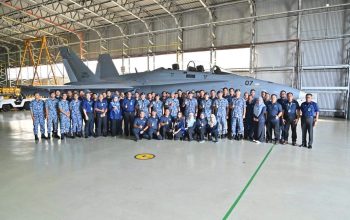Indra showcases the digital technologies that will enable the Spanish Air Force to drastically increase the level of operational availability of its aircraft, the control of its operations and the efficiency with which it carries out its maintenance activities at the Connected, Sustainable and Intelligent Air Base (BACSI) technology demonstration sessions, currently being held in Albacete from October 18 to 20. The aim is to prepare Spanish air bases for a scenario in which artificial intelligence and data will become the key factors in ensuring the maximum possible operability of the aircraft while extending their life cycle. The technological challenge posed by the BACSI project makes Indra the best possible technological partner. The company has developed some of the key avionics systems for the Eurofighter and the F18s. Furthermore, it’s developed the automated test stands that are currently used to maintain the avionics of these aircraft. Its professionals also provide support at the Air and Space Force’s armouries and workshops.
Aftermarket Business Manager, Pelayo Alvarado, said that “Indra’s proposal is fully aligned with the Air and Space Force’s vision of moving towards bases where people, tools and processes are completely connected and the work is streamlined, applying artificial intelligence to facilitate the planning and decision-making and ensuring optimal use of the resources in a more environment-friendly manner”.
In this regard, taking the aircraft as the central asset, Indra has developed a recording system or PMDS (Portable Maintenance Data Store) that collects parameters from the Eurofighter systems in flight. As soon as it lands, the data are transmitted wirelessly to the Sherpa system, developed by Indra in accordance with the requirements of the Air and Space Force, which uses artificial intelligence to predictively detect potential failures. This information immediately reaches the specialists, who are able to access it directly via their smartwatches and tablets beside the runway. The faults, once they’ve been confirmed by the specialist, are automatically transferred to the Maesweb maintenance system of the Armouries of the Air and Space Force, together with the appropriate evidence captured by means of an innovative system with augmented reality glasses, in such a way that all the diagnostic activity is recorded and shared with the following levels of maintenance, thereby preventing the slightest loss of knowledge.
The entire maintenance operation is perfectly synchronised and supported by digital tools in the hangar. Each part, tool and mechanic will be accurately identified and geolocated using electronic labels and tags, thanks to a high-precision real-time location system (RTLS) that facilitates better task planning and more efficient stock control and supports the work of the mechanics allowing them to detect whether any resources are missing. Each of the mechanics will come with Hololens augmented reality glasses that provide them with contextual information about the systems to be repaired and give them access to the technical documentation required to guide them. Furthermore, with these glasses they can request remote support from other specialists who’ll see the same things as the mechanic, a function which is particularly useful on international missions.















